Sheffield Memorial Park, Somme Battlefields, France
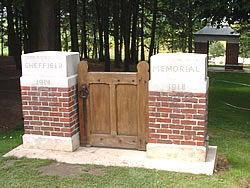
|
The Memorial Park is in the location of the British Front Line for 1st July 1916. At the time there were four small woods in this sector. They were known on British Army maps from south to north as Matthew Copse, Mark Copse, Luke Copse and John Copse.
During the war the trees in these copses were shattered by artillery shellfire, leaving the tree trunks as splintered stumps. The wood was fenced off to form the site of the Memorial Park and its grounds and trees now cover the location of three of the copses: Mark, Luke and John. Matthew Copse, which was sited just to the south of the Memorial Park, has not regrown into a wood.
The Pals Battalions
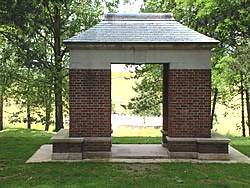
|
Sheffield Memorial Park remembers the men of the British Army's 31st Division who served with the Pals Battalions. Of the 12 battalions in the 31st Division, all but two were recruited from Yorkshire, one of these being from Durham and the other from Lancashire. The Pals Battalions were formed in the autumn of 1914 following a recruiting drive by the War Office. Thousands of men rushed to the recruiting offices to join up as enthusiastic volunteers to help with the war effort.
In the county of Yorkshire alone within a matter of days several battalions had been formed at their maximum strength of 800-900 men each. These battalions were attached to existing regiments and given a new battalion number followed by the word 'Service', for example, the 12th Service Battalion, York & Lancaster Regiment. This battalion became known as the Sheffield City battalion because it was recruited from Sheffield and was chiefly made up of men from the city. At that time the encouragement to join up as part of the recruiting campaign played on the idea that men from similar working trades and professions, and sports or social clubs should enlist together. The tragic consequences of this idea would be played out when these men went into action to fight together.
Most of the Pals Battalions spent up to 18 months in training before arriving in northern France in the spring of 1916 where they began to prepare to take part in the Battle of the Somme. This was to be a large-scale attack to be launched by the British Army on a 15 mile front against the German Army's well fortified positions. Most of the Pals Battalions in 31st Division went into action from this part of the British Front Line on the morning of 1st July 1916. They were well trained and moral was good, but they were inexperienced in battle. Their division was in position at the far northern end of the 15 mile front of the attack. The task of 31st Division was to advance east through the German Front line and capture the fortified village of Serre, several hundred yards ahead of the British Front Line. The German regiment on the other side of the wire was the 169th Infantry Regiment. Once beyond the village the division was to pivot at a 90 degree angle to face north, whilst keeping touch with its neighbour, the British 48th Division, on its left. This would be a difficult manoeuvre to make even if the men were not under fire.

The photo is taken looking in a north-westerly direction towards Sheffield Memorial Park from the British Front Line of 1st July 1916. The Front Line follows the track past Serre Road No. 3 cemetery and turns to the north along the edge of the wood at Sheffield Park, formerly being the location of Mark, Luke and John Copses.
The positions of the first and second line battalions are indicated on the photo. They had moved forward from the rear areas into these positions - called the Assembly Trenches - on and just behind the British Front Line during the evening of 30 June into the early hours of 1 July. Battalion War Diaries record that the men were given a meal before they set off on their march from the rear to these positions. Many received hot tea and rum too.
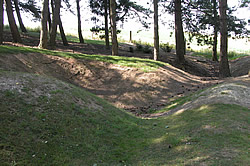
|
Some battalions suffered casualties from German artillery shelling just before the infantry attack began at 07.30 hours on 1 July. Ten minutes before Zero at 07.20 hours a smoke screen was started which blew gently across No Man's Land on a westerly breeze. This prompted German machine gunners to open fire. The German artillery also put down a curtain of fire onto the British trenches.
The 14th Battalion York & Lancs (2nd Barnsley Pals) recorded in the War Diary that they suffered 30% casualties from shelling, machine gun and rifle fire onto their Assembly trench (Nairne trench) which was at the rear of the British Front Line behind John Copse. The trench “was completely levelled, and so much exposed that it appeared to form part of No Man's Land” and John Copse resembled “a heap of debris”. (1)
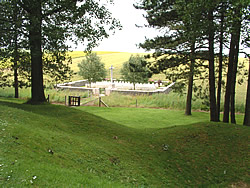
|
The 16th Battalion West Yorks (1st Bradford Pals) reported that in the five minutes before Zero hour, between 07.25 and 07.30 hours, the Germans directed machine gun, rifle fire and shrapnel shells on its Assembly trenches also. The men were climbing up the trench ladders out of the Assembly trenches to move forward into the British Front Line trench. They were to follow on behind the 15th West Yorks (Leeds Pals) who were in front of them leading the attack. Casualties were heavy. According to a statement by Sergeant-Major Cussins:
“A lot of men never got off the ladder but fell back; and many fell back from the parapet in getting over... On getting out of the trenches to take up our position in front, we lost heavily, through the line of shrapnel, machine gun and rapid rifle fire; by the time we attained our position in front of Bradford trench most of the officers, N.C.O.s [Non-Commissioned Officers], and many men were knocked out.” (2)
2nd Lieutenant Charles Laxton, also of the 16th West Yorks (1st Bradford Pals) recorded that at 07.25 hours, five minutes before Zero, he left the battalion headquarters dugout with the battalion commander, Major Guyon. 2nd Lieutenant Laxton was the Intelligence Officer and A.D.C. to Major Guyon. Accompanied by several other battalion Staff officers they started to make their way to the front line. However, within a couple of minutes Major Guyon was struck through the helmet by a bullet in the temple. Although the commander was unconscious and even though Laxton records in a statement to the War Diary that the man was apparently dying, he bandaged him up. (3) The body of Major George S Guyon, aged 41 when he died on 1st July, has never been found. He is recorded on the Thiepval Memorial to the Missing (Pier and Face 9A) with the rank of Lieutenant Colonel.
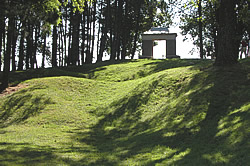
|
The casualties of the Pals Battalions who went into action on 1st July were very heavy. Most of these battalions went into the attack at a strength of about 600-700 men. Some men had been left behind in the rear area from each battalion. The War Diaries record the tragedy of the day where so few men even reached the German Front Line trench before being wounded or killed. The account by the 14th York & Lancs writes of the move from the Assembly trench to the British Front line trench and into No Man's Land with: “Although this advance had to be carried out under a perfect tornado of fire all ranks advanced as steadily as if on a drill parade.” (4) Casualties reported at the end of the day by each battalion were several hundred missing, wounded or killed.
As an example, the 12th York & Lancs (Sheffield City Battalion), reported 468 Other Ranks and 15 Officers missing, wounded or killed. The records of Soldiers Died in the Great War give the names of 241 Other Ranks and 7 Officers killed on 1 July. Many of the dead lying beyond the British Front Line of 1st July would never be recovered and their names would later be carved on the Thiepval Memorial to the Missing. Some men were recovered when the fighting moved eastward beyond the 1 July Front Lines in 1917. Some of the Pals are buried in cemeteries nearby such as Serre Road No. 2. Others who were carried behind the lines to be given medical aid and subsequently died are buried in rear area cemeteries. It was a similar story for the other Pals Battalions in action on 1 July.
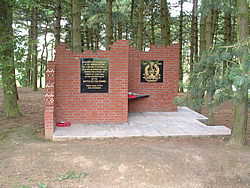
|
Memorial to the Accrington Pals
The memorial was built with red Accrington brick and dedicated to the memory of all members of the Accrington Pals, the 11th (Service) Battalion East Lancashire Regiment, who fought and fell in this location in the opening phase of the Battle of the Somme.
The memorial stands in the south east corner of the wood. It is in the position of the 1st July British Front Line where the 11th East Lancs (Accrington Pals) began their attack on that day.
The 31st Division and the Pals Battalions
The British 31st Division was made up of three brigades, with four battalions in each. The “Pals” nickname for each battalion is given in brackets.
92nd Brigade
- 10th Battalion East Yorkshire Regiment (Hull Commercials)
- 11th Battalion East Yorkshire Regiment (Hull Tradesmen)
- 12th Battalion East Yorkshire Regiment (Hull Sportsmen)
- 13th Battalion East Yorkshire Regiment (Hull T'others)
93rd Brigade
- 15th Battalion West Yorkshire Regiment (Leeds Pals)
- 16th Battalion West Yorkshire Regiment (1st Bradford)
- 18th Battalion West Yorkshire Regiment (2nd Bradford)
- 18th Battalion Durham Light Infantry (Durham Pals)
94th Brigade
- 12th Battalion York & Lancaster Regiment (Sheffield City)
- 13th Battalion York & Lancaster Regiment (1st Barnsley)
- 14th Battalion York & Lancaster Regiment (2nd Barnsley)
- 11th Battalion East Lancashire Regiment (Accrington Pals)
Pioneer Battalion
- 12th Battalion Kings Own Yorkshire Light Infantry (Leeds Miners)
Sergeant John William Streets
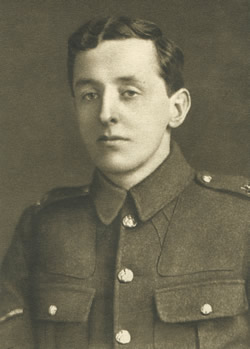
|
One of the many hundreds of casualties on the morning of 1st July in this location was the poet John William Streets. John's body was not found for almost a year.
Sergeant John William StreetsLocation of Sheffield Memorial Park
Sheffield Memorial Park is located north of the D919 road to the north-west of Serre village (the red flag on the map shown here).
Latitude N 50° 6' 21" ; Longitude E 2° 39' 23"
Access to Sheffield Park Memorial Park
Access to the memorial site is by a farm track from the D919 Serre-Mailly-Maillet road.
Notice to Visitors
Visitors are advised that the farmer who works this land has become increasingly frustrated with cars blocking his access on the track. Cars should be parked at Serre Road Cemetery No. 1 or 2 or the French military cemetery on the Serre - Mailly-Maillet road and visitors are advised to visit Sheffield Memorial Park and the military cemeteries close to it on foot.
Entry into the memorial park is through a wooden gate. The park is open daily (not restricted to specific opening hours). Visitors are reminded that it is a former battle site and the ground is uneven. As with many of the sites on the old battlefields of 1914-1918 this ground in and around the memorial park is the final resting place of those whose bodies have never been found.
The grounds of the park are administered by the Commonwealth War Graves Commission.
Website: www.cwgc.org
Related Topics
War Graves on the Western Front
The article provides background to the burial of military dead from the 1914-1918 war. It explains why so many casualties are recorded as “Missing” and have no known grave:
War Graves for WW1 Dead on The Western FrontRegisters for WW1 Military Burials and Commemorations
For more information about the organizations responsible for the maintenance of graves and memorials to servicemen and women go to:
War Grave AgenciesCemeteries on the Somme Battlefields
There are many military cemeteries on the Somme 1914-1918 battlefields. For a comprehensive list and locations go to:
Cemeteries on the Somme BattlefieldsRelated Reading

Serre: Somme (Battleground Europe Series)
by Jack Horsfall
Highly recommended guidebook by the late Jack Horsfall. 144 pages. Published by Pen & Sword Books (14 Mar 1996), ISBN-10: 085052508X; ISBN-13: 978-0850525083

Pals on the Somme 1916
by Roni Wilkinson
Recommended reading for the history of the Pals battalions, how they were formed and how they were in action during the Battle of the Somme in 1916. 160 pages. Published by Pen & Sword Military (17 April 2008), ISBN-10: 1844157652; ISBN-13: 978-1844157655

Accrington Pals: The 11th (Service) Battalion (Accrington) East Lancashire Regiment
by William Turner
Highly recommended. 256 pages. Published by Pen & Sword Books (14 Sep 1993), ISBN-10: 0850523605; ISBN-13: 978-0850523607

Barnsley Pals: 13th & 14th York & Lancaster Regiment
by Jon Cooksey
Highly recommended. 320 pages. Published by Pen & Sword Military (20 Mar 2008), ISBN-10: 1844157075; ISBN-13: 978-1844157075

Bradford Pals: The Comprehensive History of the 16th, 18th and 20th (Service) Battalions of the Prince of Wales' Own West Yorkshire Regiment 1914-1918
by David Raw
Highly recommended. 320 pages. Published by Pen & Sword Military (15 Jun 2006), ISBN-10: 1844153703; ISBN-13: 978-1844153701

Bradford in the Great War
by Bradford World War I Group
Personal accounts and fascinating stories about the impact of the Great War on an English town. 160 pages. Published by The History Press Ltd (21 Jul 2007), ISBN-10: 0750946180; ISBN-13: 978-0750946186

Durham Pals: 18th, 19th, 20th and 22nd Battalions of the Durham Light Infantry in the Great War
by John Sheen
Highly recommended. 224 pages. Published by Pen & Sword Military (15 Feb 2006), ISBN-10: 1844154955; ISBN-13: 978-1844154951

Hull Pals: 10th, 11th, 12th and 13th (Service) Battalions of the East Yorkshire Regiment - A History of the 92nd Infantry Brigade, 31st Division, 1914-19
by David Bilton
Highly recommended. 264 pages. Published by Wharncliffe Books (16 Mar 1999), ISBN-10: 0850526345; ISBN-13: 978-0850526349

Leeds Pals: History of the 15th (Service) Battalion (1st Leeds) the Prince of Wales' Own (West Yorkshire Regiment), 1914-18
by Laurie Milner
Highly recommended. 280 pages. Published by Wharncliffe Books (14 Sep 1993), ISBN-10: 0850523354; ISBN-13: 978-0850523355

Sheffield Pals: The 12th (Service) Battalion York and Lancaster Regiment
by Ralph Gibson and Paul Oldfield
Highly recommended. 256 pages. Published by Pen & Sword Military (30 Jun 2010), ISBN-10: 1848843445; ISBN-13: 978-1848843448
Useful Links
The Accrington Pals: a website by Andrew Jackson dedicated to the memory of 11th (Service) Battalion (Accrington) East Lancashire Regiment, better known as the Accrington Pals. It contains features about the history of the battalion, individual's stories, life in the trenches and the battalion in the Battle of the Somme 1916.
The Barnsley Pals: a website by Andrew Jackson dedicated to the memory of 13th and 14th (Service) Battalions York & Lancaster Regiment. Pages include the Battalion War Diaries for 1 July 1916.
The Leeds Pals: a website by Stephen Michael Wood dedicated to the 15th (Service) Battalion West Yorkshire Regiment.
The Sheffield City Battalion: a website about the history of the 12th (Service) Battalion York & Lancaster Regiment. The information is drawn from Richard Sparling's book published in 1920.
Hubert Conway Rees: The Attack on Serre, 1st July 1916. An extract from the memoirs of Brigadier-General Hubert Conway Rees, CMG, DSO, who commanded the 94th Brigade on the day of 1st July 1916. The extract is published on a website dedicated to the men of the Pals Battalions.
Acknowledgements
(1) War Diary of the 14th Battalion York & Lancs Regiment (2nd Barnsley Pals) Source: National Archives reference WO 95/2365
(2) War Diary of the 16th Battalion West Yorkshire Regiment (1st Bradford Pals) Source: National Archives reference WO 95/2362
(3) War Diary of the 16th Battalion West Yorkshire Regiment (1st Bradford Pals) Source: National Archives reference WO 95/2362
(4) War Diary of the 14th Battalion York & Lancs Regiment (2nd Barnsley Pals) Source: National Archives reference WO 95/2365